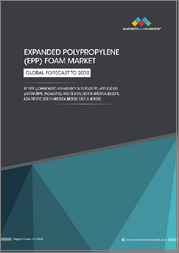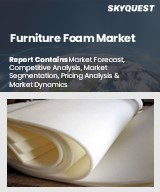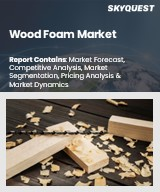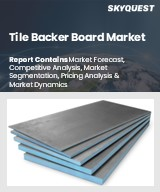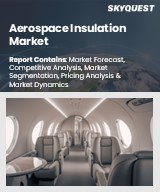
|
시장보고서
상품코드
1607040
세계의 폼 발포제 시장 : 제품 유형, 용도, 최종 용도별 예측(2025-2030년)Foam Blowing Agents Market by Product Type (Hydrocarbon, Hydrochlorofluorocarbons (HCFCs), Hydrofluoroolefin), Application (Phenolic Foams, Polystyrene Foams, Polyurethane Foams), End-Use - Global Forecast 2025-2030 |
||||||
폼 발포제 시장은 2023년에 16억 3,000만 달러로 평가되었고, 2024년에는 17억 2,000만 달러에 도달할 것으로 예측되며, CAGR 5.44%로 성장하고, 2030년에는 23억 7,000만 달러에 달할 것으로 예상됩니다.
폼 발포제는 폴리머 발포체의 형성을 촉진하는 물질이며, 건축, 자동차, 일렉트로닉스 등의 산업에 응용되고 있습니다. 폼 발포제의 주요 필요성은 이산화탄소 배출량 감소 및 에너지 효율 향상에 대한 규제 강화로 에너지 효율적인 건물 및 경량 자동차 재료에 대한 수요 요점이 높아지고 있는 것에 기인합니다. 특히 신흥국에서는 건설 섹터가 활황을 나타내고 있어 자동차 산업은 보다 경량으로 연비가 좋은 자동차를 목표로 하고 있기 때문에 그 응용 범위는 널리 유망합니다. 성장 요인으로는 하이드로 플루오로 올레핀(HFO)과 같은 환경 친화적인 약물의 진보와 환경 친화적인 건축자재를 장려하는 정부 정책을 포함합니다. 현재의 잠재적인 비즈니스 기회는 기존의 탄화수소에 대한 의존성을 줄이고 바이오과 지속 가능한 화학으로의 확대에 있습니다. 이를 위한 연구개발비용의 높이와 같은 과제에 직면하고 있습니다. 혁신의 기회가 익은 분야에, 제로 GWP제의 개발, 발포체의 내열 특성의 향상, 순환성을 높이기 위한 리사이클 재료에 적합한 제의 개발 등이 있습니다. 시장은 역동적이고 지속적인 기술 진보와 규제의 변화가 있기 때문에 기업은 민첩성을 유지하고 환경 문제를 해결하면서 새로운 기회를 활용하기 위해 지속가능성에 초점을 맞춘 연구 개발에 투자해야합니다.
| 주요 시장 통계 | |
|---|---|
| 기준년(2023) | 16억 3,000만 달러 |
| 추정년(2024) | 17억 2,000만 달러 |
| 예측년(2030) | 23억 7,000만 달러 |
| CAGR(%) | 5.44% |
시장 역학: 빠르게 진화하는 폼 발포제 시장의 주요 시장 인사이트 공개
폼 발포제 시장은 수요 및 공급의 역동적인 상호 작용에 의해 변모를 이루고 있습니다. 그리고 새로운 비즈니스 기회 획득에 대비 할 수 있습니다. 이러한 동향을 종합적으로 파악함으로써 기업은 정치적, 지리적, 기술적, 사회적, 경제적 영역에 걸친 다양한 리스크를 경감할 수 있어, 소비자 행동과 그것 제조 비용과 구매 동향에 미치는 영향을보다 명확하게 이해할 수 있습니다.
- 시장 성장 촉진요인
- 세계의 건축 및 건설 활동 증가
- HVAC 시스템 및 자동차 분야에서의 응용
- 폴리머 수지의 형성에 있어서의 이용
- 시장 성장 억제요인
- 폼 발포제의 대체품의 이용가능성
- 시장 기회
- 폼 발포제 제조 기술의 진보
- 폼 발포제 제조 시설의 확대
- 시장의 과제
- 폼 발포제 제조에 따른 환경 문제
Porter's Five Force : 폼 발포제 시장을 탐색하는 전략 도구
Porter's Five Force Framework는 폼 발포제 시장 경쟁 구도를 이해하는 중요한 도구입니다. 프레임워크는 기업이 시장 내 세력도를 평가하고 신규 사업의 수익성을 판단하는 데 도움이 됩니다. 더 강인한 시장에서 포지셔닝을 보장 할 수 있습니다.
PESTLE 분석 : 폼 발포제 시장의 외부 영향을 파악
외부 거시 환경 요인은 폼 발포제 시장의 성과 역학을 형성하는 데 매우 중요한 역할을합니다. PESTLE 요인을 조사함으로써 기업은 잠재적인 위험과 기회를 더 잘 이해할 수 있습니다. 적극적인 의사 결정을 할 준비가되어 있습니다.
시장 점유율 분석 : 폼 발포제 시장 경쟁 구도 파악
폼 발포제 시장의 상세한 시장 점유율 분석을 통해 공급업체의 성과를 종합적으로 평가할 수 있습니다. 분명히 이 분석을 통해 시장 집중, 단편화, 통합 동향을 밝혀내고 벤더는 경쟁이 치열해지는 가운데 자사의 지위를 높이는 전략적 의사 결정을 내리는 데 필요한 지견을 얻을 수 있습니다.
FPNV 포지셔닝 매트릭스 : 폼 발포제 시장에서 공급업체의 성능 평가
FPNV 포지셔닝 매트릭스는 폼 발포제 시장에서 공급업체를 평가하는 중요한 도구입니다. 이 행렬을 통해 비즈니스 조직은 공급업체의 비즈니스 전략과 제품 만족도를 기준으로 평가하여 목표에 맞는 충분한 정보를 바탕으로 의사 결정을 내릴 수 있습니다. 네 가지 사분면을 통해 공급업체를 명확하고 정확하게 부문화하고 전략 목표에 가장 적합한 파트너 및 솔루션을 파악할 수 있습니다.
전략 분석 및 권장 : 폼 발포제 시장에서 성공에 대한 길을 그립니다.
폼 발포제 시장의 전략 분석은 세계 시장에서의 존재를 강화하려는 기업에게 필수적입니다. 주요 자원, 역량 및 성과 지표를 검토함으로써 기업은 성장 기회를 파악하고 개선을 위해 노력할 수 있습니다. 이러한 접근 방식을 통해 경쟁 구도에서 과제를 극복하고 새로운 비즈니스 기회를 활용하여 장기적인 성공을 거둘 수 있는 체제를 구축할 수 있습니다.
이 보고서는 주요 관심 분야를 포괄하는 시장의 종합적인 분석을 제공합니다.
1. 시장 침투: 현재 시장 환경의 상세한 검토, 주요 기업의 광범위한 데이터, 시장 도달범위 및 전반적인 영향력 평가.
2. 시장 개척도: 신흥 시장의 성장 기회를 파악하고, 기존 분야의 확장 가능성을 평가하고, 미래 성장을 위한 전략적 로드맵을 제공합니다.
3. 시장 다양화: 최근 제품 출시, 미개척 지역, 업계의 주요 진보, 시장을 형성하는 전략적 투자를 분석합니다.
4. 경쟁 평가 및 정보 : 경쟁 구도를 철저히 분석하여 시장 점유율, 사업 전략, 제품 포트폴리오, 인증, 규제 당국 승인, 특허 동향, 주요 기업의 기술 진보 등을 검증합니다.
5. 제품 개발 및 혁신 : 미래 시장 성장을 가속할 것으로 예상되는 최첨단 기술, R&D 활동, 제품 혁신을 강조합니다.
또한 이해관계자가 충분한 정보를 얻고 의사결정을 할 수 있도록 중요한 질문에 대답하고 있습니다.
1. 현재 시장 규모와 향후 성장 예측은?
2. 최고의 투자 기회를 제공하는 제품, 부문 및 지역은 어디입니까?
3. 시장을 형성하는 주요 기술 동향과 규제의 영향은?
4. 주요 벤더의 시장 점유율과 경쟁 포지션은?
5. 벤더 시장 진입·철수 전략의 원동력이 되는 수익원과 전략적 기회는 무엇인가?
목차
제1장 서문
제2장 조사 방법
제3장 주요 요약
제4장 시장 개요
제5장 시장 인사이트
- 시장 역학
- 성장 촉진요인
- 세계에서 건축 및 건설 활동이 증가
- HVAC 시스템 및 자동차 분야에서의 응용
- 폴리머 수지의 형성에 있어서의 이용
- 억제요인
- 폼 발포제의 대체품의 이용가능성
- 기회
- 폼 발포제 제조 기술의 진보
- 폼 발포제 제조 시설의 확장
- 과제
- 폼 발포제 생산과 관련된 환경 문제
- 성장 촉진요인
- 시장 세분화 분석
- Porter's Five Forces 분석
- PESTEL 분석
- 정치
- 경제
- 사회
- 기술
- 법률
- 환경
제6장 폼 발포제 시장 : 제품 유형별
- 탄화수소
- 하이드로클로로플루오로카본(HCFC)
- 하이드로플루오로올레핀
- 메틸랄과 포름산메틸
제7장 폼 발포제 시장 : 용도별
- 페놀 폼
- 폴리스티렌 폼
- 폴리우레탄 폼
제8장 폼 발포제 시장 : 최종 용도별
- 자동차
- 건축 및 건설
- 전기 및 전자
- 가구 및 침구
제9장 아메리카의 폼 발포제 시장
- 아르헨티나
- 브라질
- 캐나다
- 멕시코
- 미국
제10장 아시아태평양의 폼 발포제 시장
- 호주
- 중국
- 인도
- 인도네시아
- 일본
- 말레이시아
- 필리핀
- 싱가포르
- 한국
- 대만
- 태국
- 베트남
제11장 유럽·중동 및 아프리카의 폼 발포제 시장
- 덴마크
- 이집트
- 핀란드
- 프랑스
- 독일
- 이스라엘
- 이탈리아
- 네덜란드
- 나이지리아
- 노르웨이
- 폴란드
- 카타르
- 러시아
- 사우디아라비아
- 남아프리카
- 스페인
- 스웨덴
- 스위스
- 터키
- 아랍에미리트(UAE)
- 영국
제12장 경쟁 구도
- 시장 점유율 분석 2023
- FPNV 포지셔닝 매트릭스, 2023
- 경쟁 시나리오 분석
- 전략 분석과 제안
기업 목록
- AGC Inc.
- Arkema SA
- Avient Corporation
- BASF SE
- Chase Corporation
- DuPont de Nemours, Inc.
- Eiwa Chemical Industry Co., Ltd.
- Exxon Mobil Corporation
- Harp International Ltd.
- HCS Group
- Honeywell International Inc.
- Jiangxi Selon Industrial Co., Ltd.
- Lanxess AG
- Linde PLC
- LyondellBasell Industries Holdings BV
- Merck KGaA
- Mitsubishi Gas Chemical Company, Inc.
- Nouryon Chemicals Holding BV
- Reedy Chemical Foam
- Solvay SA
- The Chemours Company
- Yuji America Corp.
- Zeon Taiwan Co., Ltd.
- Zhejiang Shuntai Technology CO., LTD.
The Foam Blowing Agents Market was valued at USD 1.63 billion in 2023, expected to reach USD 1.72 billion in 2024, and is projected to grow at a CAGR of 5.44%, to USD 2.37 billion by 2030.
Foam blowing agents are substances that enhance the formation of polymer foams, with applications spanning industries such as construction, automotive, and electronics. These agents are vital in producing materials like polyurethane or polystyrene foams, which are essential for insulation, cushioning, and packaging solutions. The primary necessity for foam blowing agents arises from the demand for energy-efficient buildings and lightweight automotive materials, driven by increased regulations on reducing carbon footprints and improving energy efficiency. With the construction sector booming, particularly in emerging economies, and the automotive industry working towards lighter, more fuel-efficient vehicles, the application scope is broad and promising. Key growth factors include advancements in environmentally friendly agents, such as hydrofluoroolefins (HFOs), and government policies encouraging eco-friendlier construction materials. Furthermore, new resistance requirements in electrical insulation open pathways for specialized foam developments. The current potential opportunities lie in expanding into biobased and sustainable chemistry, reducing the reliance on traditional hydrocarbons. However, the market faces challenges such as stringent environmental regulations on certain chemical compositions, price volatility in raw materials, and the high costs of R&D for innovative solutions. The foam blowing agents market is competitive, with major players focusing on developing lower-GWP (global warming potential) alternatives. Areas ripe for innovation include the development of zero-GWP agents, increasing the thermal resistance properties of foams, and creating agents compatible with recycled materials to enhance circularity. Research into new catalysts and process insulation technologies can further optimize production methods. The market is dynamic, with continuous technological advancements and regulatory shifts, highlighting the need for companies to remain agile and invest in sustainability-focused R&D to capitalize on emerging opportunities while addressing environmental concerns.
| KEY MARKET STATISTICS | |
|---|---|
| Base Year [2023] | USD 1.63 billion |
| Estimated Year [2024] | USD 1.72 billion |
| Forecast Year [2030] | USD 2.37 billion |
| CAGR (%) | 5.44% |
Market Dynamics: Unveiling Key Market Insights in the Rapidly Evolving Foam Blowing Agents Market
The Foam Blowing Agents Market is undergoing transformative changes driven by a dynamic interplay of supply and demand factors. Understanding these evolving market dynamics prepares business organizations to make informed investment decisions, refine strategic decisions, and seize new opportunities. By gaining a comprehensive view of these trends, business organizations can mitigate various risks across political, geographic, technical, social, and economic domains while also gaining a clearer understanding of consumer behavior and its impact on manufacturing costs and purchasing trends.
- Market Drivers
- Increase in building and construction activities worldwide
- Applications in HVAC systems and the automobiles sector
- Utilization in the formation of polymer resins
- Market Restraints
- Availability of substitutes for foam-blowing agents
- Market Opportunities
- Advancements in foam blowing agents manufacturing technology
- Expansion of foam blowing agents manufacturing facilities
- Market Challenges
- Environmental issues associated with the production of foam blowing agents
Porter's Five Forces: A Strategic Tool for Navigating the Foam Blowing Agents Market
Porter's five forces framework is a critical tool for understanding the competitive landscape of the Foam Blowing Agents Market. It offers business organizations with a clear methodology for evaluating their competitive positioning and exploring strategic opportunities. This framework helps businesses assess the power dynamics within the market and determine the profitability of new ventures. With these insights, business organizations can leverage their strengths, address weaknesses, and avoid potential challenges, ensuring a more resilient market positioning.
PESTLE Analysis: Navigating External Influences in the Foam Blowing Agents Market
External macro-environmental factors play a pivotal role in shaping the performance dynamics of the Foam Blowing Agents Market. Political, Economic, Social, Technological, Legal, and Environmental factors analysis provides the necessary information to navigate these influences. By examining PESTLE factors, businesses can better understand potential risks and opportunities. This analysis enables business organizations to anticipate changes in regulations, consumer preferences, and economic trends, ensuring they are prepared to make proactive, forward-thinking decisions.
Market Share Analysis: Understanding the Competitive Landscape in the Foam Blowing Agents Market
A detailed market share analysis in the Foam Blowing Agents Market provides a comprehensive assessment of vendors' performance. Companies can identify their competitive positioning by comparing key metrics, including revenue, customer base, and growth rates. This analysis highlights market concentration, fragmentation, and trends in consolidation, offering vendors the insights required to make strategic decisions that enhance their position in an increasingly competitive landscape.
FPNV Positioning Matrix: Evaluating Vendors' Performance in the Foam Blowing Agents Market
The Forefront, Pathfinder, Niche, Vital (FPNV) Positioning Matrix is a critical tool for evaluating vendors within the Foam Blowing Agents Market. This matrix enables business organizations to make well-informed decisions that align with their goals by assessing vendors based on their business strategy and product satisfaction. The four quadrants provide a clear and precise segmentation of vendors, helping users identify the right partners and solutions that best fit their strategic objectives.
Strategy Analysis & Recommendation: Charting a Path to Success in the Foam Blowing Agents Market
A strategic analysis of the Foam Blowing Agents Market is essential for businesses looking to strengthen their global market presence. By reviewing key resources, capabilities, and performance indicators, business organizations can identify growth opportunities and work toward improvement. This approach helps businesses navigate challenges in the competitive landscape and ensures they are well-positioned to capitalize on newer opportunities and drive long-term success.
Key Company Profiles
The report delves into recent significant developments in the Foam Blowing Agents Market, highlighting leading vendors and their innovative profiles. These include AGC Inc., Arkema S.A., Avient Corporation, BASF SE, Chase Corporation, DuPont de Nemours, Inc., Eiwa Chemical Industry Co., Ltd., Exxon Mobil Corporation, Harp International Ltd., HCS Group, Honeywell International Inc., Jiangxi Selon Industrial Co., Ltd., Lanxess AG, Linde PLC, LyondellBasell Industries Holdings B.V., Merck KGaA, Mitsubishi Gas Chemical Company, Inc., Nouryon Chemicals Holding B.V., Reedy Chemical Foam, Solvay S.A., The Chemours Company, Yuji America Corp., Zeon Taiwan Co., Ltd., and Zhejiang Shuntai Technology CO., LTD..
Market Segmentation & Coverage
This research report categorizes the Foam Blowing Agents Market to forecast the revenues and analyze trends in each of the following sub-markets:
- Based on Product Type, market is studied across Hydrocarbon, Hydrochlorofluorocarbons (HCFCs), Hydrofluoroolefin, and Methylal & Methyl Formate.
- Based on Application, market is studied across Phenolic Foams, Polystyrene Foams, and Polyurethane Foams.
- Based on End-Use, market is studied across Automotive, Building & Construction, Electrical & Electronics, and Furniture & Bedding.
- Based on Region, market is studied across Americas, Asia-Pacific, and Europe, Middle East & Africa. The Americas is further studied across Argentina, Brazil, Canada, Mexico, and United States. The United States is further studied across California, Florida, Illinois, New York, Ohio, Pennsylvania, and Texas. The Asia-Pacific is further studied across Australia, China, India, Indonesia, Japan, Malaysia, Philippines, Singapore, South Korea, Taiwan, Thailand, and Vietnam. The Europe, Middle East & Africa is further studied across Denmark, Egypt, Finland, France, Germany, Israel, Italy, Netherlands, Nigeria, Norway, Poland, Qatar, Russia, Saudi Arabia, South Africa, Spain, Sweden, Switzerland, Turkey, United Arab Emirates, and United Kingdom.
The report offers a comprehensive analysis of the market, covering key focus areas:
1. Market Penetration: A detailed review of the current market environment, including extensive data from top industry players, evaluating their market reach and overall influence.
2. Market Development: Identifies growth opportunities in emerging markets and assesses expansion potential in established sectors, providing a strategic roadmap for future growth.
3. Market Diversification: Analyzes recent product launches, untapped geographic regions, major industry advancements, and strategic investments reshaping the market.
4. Competitive Assessment & Intelligence: Provides a thorough analysis of the competitive landscape, examining market share, business strategies, product portfolios, certifications, regulatory approvals, patent trends, and technological advancements of key players.
5. Product Development & Innovation: Highlights cutting-edge technologies, R&D activities, and product innovations expected to drive future market growth.
The report also answers critical questions to aid stakeholders in making informed decisions:
1. What is the current market size, and what is the forecasted growth?
2. Which products, segments, and regions offer the best investment opportunities?
3. What are the key technology trends and regulatory influences shaping the market?
4. How do leading vendors rank in terms of market share and competitive positioning?
5. What revenue sources and strategic opportunities drive vendors' market entry or exit strategies?
Table of Contents
1. Preface
- 1.1. Objectives of the Study
- 1.2. Market Segmentation & Coverage
- 1.3. Years Considered for the Study
- 1.4. Currency & Pricing
- 1.5. Language
- 1.6. Stakeholders
2. Research Methodology
- 2.1. Define: Research Objective
- 2.2. Determine: Research Design
- 2.3. Prepare: Research Instrument
- 2.4. Collect: Data Source
- 2.5. Analyze: Data Interpretation
- 2.6. Formulate: Data Verification
- 2.7. Publish: Research Report
- 2.8. Repeat: Report Update
3. Executive Summary
4. Market Overview
5. Market Insights
- 5.1. Market Dynamics
- 5.1.1. Drivers
- 5.1.1.1. Increase in building and construction activities worldwide
- 5.1.1.2. Applications in HVAC systems and the automobiles sector
- 5.1.1.3. Utilization in the formation of polymer resins
- 5.1.2. Restraints
- 5.1.2.1. Availability of substitutes for foam-blowing agents
- 5.1.3. Opportunities
- 5.1.3.1. Advancements in foam blowing agents manufacturing technology
- 5.1.3.2. Expansion of foam blowing agents manufacturing facilities
- 5.1.4. Challenges
- 5.1.4.1. Environmental issues associated with the production of foam blowing agents
- 5.1.1. Drivers
- 5.2. Market Segmentation Analysis
- 5.3. Porter's Five Forces Analysis
- 5.3.1. Threat of New Entrants
- 5.3.2. Threat of Substitutes
- 5.3.3. Bargaining Power of Customers
- 5.3.4. Bargaining Power of Suppliers
- 5.3.5. Industry Rivalry
- 5.4. PESTLE Analysis
- 5.4.1. Political
- 5.4.2. Economic
- 5.4.3. Social
- 5.4.4. Technological
- 5.4.5. Legal
- 5.4.6. Environmental
6. Foam Blowing Agents Market, by Product Type
- 6.1. Introduction
- 6.2. Hydrocarbon
- 6.3. Hydrochlorofluorocarbons (HCFCs)
- 6.4. Hydrofluoroolefin
- 6.5. Methylal & Methyl Formate
7. Foam Blowing Agents Market, by Application
- 7.1. Introduction
- 7.2. Phenolic Foams
- 7.3. Polystyrene Foams
- 7.4. Polyurethane Foams
8. Foam Blowing Agents Market, by End-Use
- 8.1. Introduction
- 8.2. Automotive
- 8.3. Building & Construction
- 8.4. Electrical & Electronics
- 8.5. Furniture & Bedding
9. Americas Foam Blowing Agents Market
- 9.1. Introduction
- 9.2. Argentina
- 9.3. Brazil
- 9.4. Canada
- 9.5. Mexico
- 9.6. United States
10. Asia-Pacific Foam Blowing Agents Market
- 10.1. Introduction
- 10.2. Australia
- 10.3. China
- 10.4. India
- 10.5. Indonesia
- 10.6. Japan
- 10.7. Malaysia
- 10.8. Philippines
- 10.9. Singapore
- 10.10. South Korea
- 10.11. Taiwan
- 10.12. Thailand
- 10.13. Vietnam
11. Europe, Middle East & Africa Foam Blowing Agents Market
- 11.1. Introduction
- 11.2. Denmark
- 11.3. Egypt
- 11.4. Finland
- 11.5. France
- 11.6. Germany
- 11.7. Israel
- 11.8. Italy
- 11.9. Netherlands
- 11.10. Nigeria
- 11.11. Norway
- 11.12. Poland
- 11.13. Qatar
- 11.14. Russia
- 11.15. Saudi Arabia
- 11.16. South Africa
- 11.17. Spain
- 11.18. Sweden
- 11.19. Switzerland
- 11.20. Turkey
- 11.21. United Arab Emirates
- 11.22. United Kingdom
12. Competitive Landscape
- 12.1. Market Share Analysis, 2023
- 12.2. FPNV Positioning Matrix, 2023
- 12.3. Competitive Scenario Analysis
- 12.4. Strategy Analysis & Recommendation
Companies Mentioned
- 1. AGC Inc.
- 2. Arkema S.A.
- 3. Avient Corporation
- 4. BASF SE
- 5. Chase Corporation
- 6. DuPont de Nemours, Inc.
- 7. Eiwa Chemical Industry Co., Ltd.
- 8. Exxon Mobil Corporation
- 9. Harp International Ltd.
- 10. HCS Group
- 11. Honeywell International Inc.
- 12. Jiangxi Selon Industrial Co., Ltd.
- 13. Lanxess AG
- 14. Linde PLC
- 15. LyondellBasell Industries Holdings B.V.
- 16. Merck KGaA
- 17. Mitsubishi Gas Chemical Company, Inc.
- 18. Nouryon Chemicals Holding B.V.
- 19. Reedy Chemical Foam
- 20. Solvay S.A.
- 21. The Chemours Company
- 22. Yuji America Corp.
- 23. Zeon Taiwan Co., Ltd.
- 24. Zhejiang Shuntai Technology CO., LTD.








